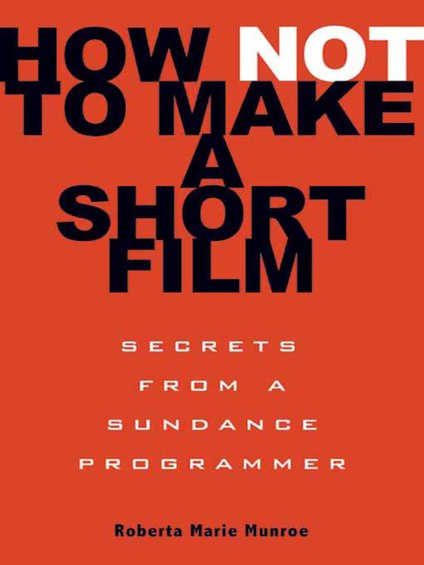
How Not to Make a Short Film-Book Review
As I learn “How Not to Make a Short Film” I felt an increasing number of cheated, not by the guide however by my movie college. Why hadn’t my instructors taught me these items? That is a guide each movie pupil, each filmmaker should learn earlier than writing, producing, or directing a brief movie. It is a must-have useful resource that guides one by filmmaking’s precarious choices and reveals how to keep away from the various errors in judgment that mark mediocre movies. Written by Roberta Marie Monroe, an award-winning filmmaker, and former Sundance Movie Pageant brief movie programmer, Roberta brings to the desk a wealth of information about each section, from conception to manufacturing to distribution.
For filmmakers, movie festivals are the most important shops they usually have grow to be the choose, jury, and typically the executioner when it comes to evaluating the price of a brief movie. By understanding what not to do you possibly can vastly improve one’s probabilities of having your work being seen and appreciated. On this respect, the guide walks you thru the minefield of errors that aspiring filmmakers and seasoned professionals make, in order that you do not have to make them your self. As well as, the guide options interviews with a lot of at this time’s most gifted writers, producers, and administrators, in addition to provocative tales from Roberta’s personal brief movie experiences.
The guide is specified by a most pragmatic style and follows the steps one would usually absorb producing a brief movie. The primary chapter on the script story talks about retaining it recent and lists a multitude of storylines to keep away from, storylines which have grow to be mundane by overuse. When programmers say, “Been there, seen it,” you lose them in addition to your viewers. This chapter I discovered most fascinating because it permits us contained in the programmer’s thoughts and the first choice standards, specifically what is the story and why ought to I watch it? This chapter additionally covers the script analysis reminiscent of hiring a guide and the professionals and cons of getting suggestions from associates.
One other chapter discusses movie size and the way it ought to match the story. DP Geary McLeod feedback, “Every single frame has to work, it has to move the story forward. ‘Economical’ is what short filmmakers need to remind themselves.” The guide goes on to level out that it is also simpler to discover a slot for an 8-12-minute movie versus a 28-minute opus. Meredith Kadlec provides, “Don’t fall into the trap of trying to prove how MUCH you can do, rather [show] how WELL you can do it.”
“How Not to… ” covers a big selection of filmmaking concerns, from choosing a producer, understanding their duties, to budgeting, plus methods to get monetary savings and lift funds. The chapter on Crewing Up is most related to first-time filmmakers. It talks concerning the synergy of a movie crew and the way to information their efforts and take care of the ever-changing dynamics. This chapter describes the important thing positions, individuals you want to seek the advice of earlier than you shoot together with subjects that want to be addressed. The chapter reiterates the necessity for harmonious collaboration and the truth that you can not do all of it by your self.
All these concerns could seem daunting at first but when they don’t seem to be addressed, your movie suffers as a outcome. After studying this guide, I used to be overwhelmed by the multitude of obligations. However then I remembered Roberta’s mantra that you simply want to have good individuals round you and this guide gives route on how to choose your assist crew. Casting is one other space the place the writer suggests searching for help. She goes by the method of discovering and hiring a casting director together with the explanations for doing so. One would assume that casting administrators would keep away from brief movies however many look on it as a approach to present work and publicity for his or her shoppers, particularly people who have breakout potential. Recommendation on auditions, rehearsals and creating a protected house on your actors in additionally provided on this chapter.
Actor Chase Gilbertson talks about how neophyte administrators typically drift off observe. “Obviously if I’m doing your film, the story was good enough in the first place but now instead of simply telling a good story, you’re trying to make a Hollywood blockbuster. Yeah, you’ve got a lot of cool toys but ultimately what is the end result? What happened to the story?” The chapter on manufacturing discusses quite a few precautions relating to the on-set expertise together with inventive options to a few of these issues. Among the finest was utilizing New York Calls to outfox an innocuous enterprise proprietor.
Different drawback areas lined embrace on-set etiquette and angle, insurance coverage and permits together with meals and craft companies. What was particularly vital is Roberta’s recommendation to have a good time, be ready, and benefit from the magical second of being a filmmaker. Publish-production is the love/hate relationship of filmmaking.
All blended collectively is the footage you like adopted by the worst photographs, lighting, efficiency, and blocking of your life. Roberta repeats a number of instances, “This is normal.” She additionally suggests studying Walter Murch’s guide “In the Blink of an Eye” to achieve some extraordinary insights into the enhancing course of. Information of how enhancing works is paramount to your success on set, she says, for then you definately’ll know which photographs are most vital to inform your story. The chapter additionally hits on how expertise has made filmmaking much less disciplined, i.e., capturing extra footage, chopping quicker, and ending up with extra variations whereas losing labor. Roberta sights a MPAA report saying that solely 2% of all feature-length movies really safe a theatrical or DVD launch.
From that one may surmise that within the brief movie world distribution might be much more tough. Orly Ravid of New American Imaginative and prescient factors out that distribution course of begins earlier than you make your movie. You want a sense of who’s the viewers, conceive the movie’s enchantment upfront and have compelling advertising illustrations or pictures that sells the movie. Orly additionally advises budgeting funds for advertising and outreach.
This chapter discusses quite a few channels for distribution however states that your brief may additionally have worth as a TV pilot or when expanded into a function. Orly’s priceless questionnaire “Is Your Film Distribution Ready?” covers probably the most problematic and ignored areas.
Academy qualification info can be lined on this chapter. Roberta makes discovering brief distributors straightforward by posting an up-to-date checklist of U.S. and worldwide firms on her web site. The chapter on the Sundance Movie Pageant gives an illuminating background in addition to efficient submission methods.
The submission do’s and don’ts checklist by Sundance programming supervisor Adam Montgomery will assist transfer you movie additional up the choice ladder. The part on publicity and advertising tells what you want, mainly a strong web site, a stellar assortment of nonetheless images and a easy enterprise card directing individuals to your website. As well as, posting a trailer will vastly improve your rating on Google and provides viewers a higher glimpse of your work. The remainder of the guide is allotted to pattern budgets, prime brief filmmaker clichés, and an intensive useful resource information. This information consists of listings of brief pleasant movie festivals, brief movie distributors, blogs, neighborhood outreach organizations, databases, plus broadcast and on-line tv firms. “How Not to Make a Short Film-Secrets from a Sundance Programmer” vividly depicts the big job that filmmaking entails. But it reveals how by avoiding the various pitfalls one can save money and time and create a brief movie that is still memorable within the minds of programmers and audiences. Nicely written and well timed, I strongly advocate this guide as an addition to each filmmaker’s useful resource library.
Erik Sean McGiven assists authors, screenwriters, and filmmakers growing and advertising their initiatives. He has written articles associated to such endeavors together with “Optimizing Social Media Efforts”, “Screenwriter Resources” and “Book Trailers: Compiling & Arranging Elements for Effective Results.” Hyperlinks to these articles and others will be discovered on http://www.erikseanmcgiven.com/writings/the-biz/. McGiven works as a screenwriter, producer and publicist within the leisure business.




